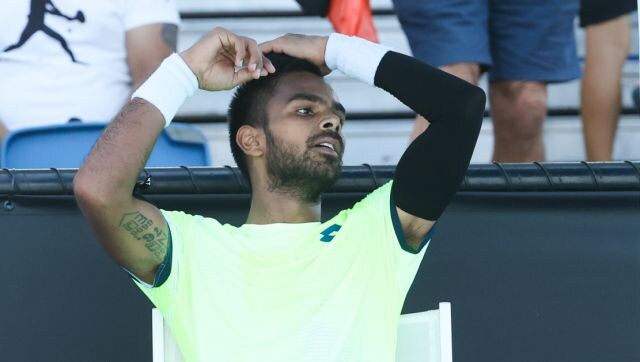
Sumit Nagal crashed out of Australian Open in straight sets in the first round. AP
Sumit Nagal's third Grand Slam main draw appearance and first at Australian Open resulted in a largely forgetful first round loss.

Sumit Nagal crashed out of Australian Open in straight sets in the first round. AP
In the lead up to the Australian Open, Sumit Nagal expected a top-10 opponent first up and admitted it brings out the best of him. When the draw was made, he didn't get one of the top seeds, like Roger Federer at 2019 US Open and Dominic Thiem at 2020 US Open, but an unseeded player. A player he had faced just a few days earlier. Lithuania's Ricardas Berankis, the world No 72 who had achieved a career best of 50 in 2016. His biggest wins had come against Daniil Medvedev (Dubai 2019), Stefanos Tsistipas (Metz 2018) and twice against Milos Raonic (Moscow 2014 and Basel 2016). A player who had beaten Nagal 6-2, 6-2 at the Murray River Open.
Nagal's gut feeling didn't go right. Neither did things on court in 2-6, 5-7, 3-6 defeat in a match that lasted two hours and 10 minutes. Placed on Court 17, the Indian wildcard started poorly and made errors at crucial junctures. Nagal had Berankis 0-40 down in the third game but allowed the Lithuanian to come back and hold. On his serve, Nagal was broken in the sixth and eighth games. On both instances, Berankis struck forehand winners to seal the deal.
At the start of the second set, an upset Nagal summed up his play thus far: 'So sad man!' And it was going to get sadder. The Indian had his serve broken twice after being stretched into the corner and a desperate run could only see the forehand into the net.
The scoreline read 2-6, 0-4 and Nagal looked down and out. His serve was not as bad as it had been against Thiem at Flushing Meadows. But his groundstrokes, usually his strong suit, weren't clicking. He had 10 forehand and 8 backhand errors in the first set. To nullify these numbers, the winners weren't working. He had just two winners on both wings in the opening set.
In the second set, his first serve remained a healthy 75 percent but it was the second serve that was taken apart. He would win just one in three second serve points while the speed dropped from an average of 150.8 kmph in the first set to 136.5 kmph in the second. It thus became no surprise that Nagal was struggling and would have his serve broken thrice in the second set and six times overall.
But at 2-6, 0-4, Nagal's groundstrokes started to work. His forehand found its depth, the gutsy and the defensive game plan was sent into the shredder. And just as Nagal found his shots, Berankis was forced into missing his. Thereafter it became a cagey contest where couple of points were going to dictate the outcome — and it did.
Nagal roared back to make it 4-4 in the second set on the back of 10 straight points in this period. Berankis was able to get his nerves in place to hold twice and put the onus on Nagal to force a tiebreak.
At 5-5 15-15, Nagal was left frustrated after missing what seemed to be a routine forehand. He had done the hard work of moving around and picking up tough balls and with Berankis at the net, Nagal had the opportunity to run around and send a winner into the open court.
Instead, his shot found the net and the frustration carried on. On the next point, his serve hit the net cord and trickled over. Clearly annoyed, Nagal looked at the chair umpire and said, "On a ball that was this high?" while gesturing at the height of the ball. With technology in play on all courts at Melbourne Park, it made no sense to argue. But the momentum carried and Berankis took a two-set lead with a forehand down the line winner. As he walked over to his chair, Nagal smashed his racket in frustration. After all that hard work and battling tennis, the anguish was justified.
Nagal dusted himself off and took court afresh after a little breather. The third set remained on serve until the eighth game as the contest became more even. Both players had their serves pushed with 63 points being played in the first seven games.
In the eighth game, serving at 3-4, Nagal let two game points go and then saved two break points to keep the game to deuce. Alas, on the third break point opportunity, Berankis struck a forehand winner to get the all important break.
Serving for the match, Berankis held firm and closed out the contest with a 182kmph ace out wide. His next opponent is Russia's 19th seed Karen Khachanov, who needed four sets to beat Australian wildcard Aleksandar Vukic.
India's hopes now rest on the doubles field with Ankita Raina, Rohan Bopanna and Divij Sharan.
Subscribe to Moneycontrol Pro at ₹499 for the first year. Use code PRO499. Limited period offer. *T&C apply